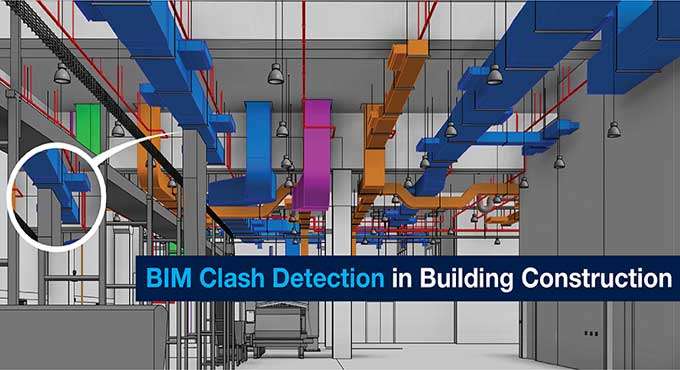In the realm of construction and architecture, the introduction of Building Information Modeling (BIM) has revolutionized the way projects are planned, designed, and executed. Among the many powerful tools that BIM offers, one of the most critical is Clash Detection. This process not only enhances project efficiency but also contributes significantly to cost savings and improved collaboration among project stakeholders. In this article, we will delve into the intricacies of BIM Clash Detection Services, exploring its process, benefits, and the promising future scope it holds for the AEC (Architecture, Engineering, and Construction) industry.
The Clash Detection Process
At its core, Clash Detection is a quality control process used during the design and construction phases of a project. Its primary purpose is to identify and resolve clashes or clashes that occur when multiple building components, systems, or elements intersect or occupy the same space within a 3D model. These clashes, if left unaddressed, can lead to construction errors, delays, increased costs, and compromised project quality.
Here’s a breakdown of the Clash Detection process:
Creation of 3D BIM Models: The process commences with the creation of detailed 3D BIM models representing various building components, including structural, architectural, mechanical, electrical, and plumbing elements. These models are created using specialized BIM software.
Integration of Multiple Disciplines: Each discipline involved in the project (e.g., architects, structural engineers, MEP engineers) develops its 3D BIM models. These models are then integrated into a single federated BIM model, known as the “Common Data Environment” (CDE). This central repository allows for real-time collaboration and coordination among different project stakeholders.
Clash Detection Software: Clash Detection software is employed to analyze the federated BIM model. The software scans the entire model, comparing the spatial relationships and dimensions of different building elements.
Identification of Clashes: The software identifies clashes or conflicts where elements intersect or occupy the same space within the model. Clashes are categorized based on their severity, with critical clashes requiring immediate attention, while non-critical clashes may be addressed later in the project.
Clash Reports: Clash Detection software generates detailed clash reports, providing information on the type of clash, its location within the model, and the disciplines involved. These reports serve as a guide for resolving clashes.
Resolution: Project stakeholders, including architects, engineers, and contractors, collaborate to resolve identified clashes. This may involve making design revisions, adjusting dimensions, or re-routing systems to eliminate clashes.
Continuous Monitoring: Clash Detection is an iterative process that continues throughout the design and construction phases. As new information becomes available or design changes are made, clash detection is repeated to ensure ongoing clash resolution.
Benefits of Clash Detection in BIM
The adoption of Clash Detection in BIM offers several significant advantages to construction projects:
Error Prevention: By identifying clashes early in the design phase, Clash Detection helps prevent costly errors and rework during construction.
Time Savings: Resolving clashes before construction begins leads to smoother workflows, reduces project delays, and accelerates the construction timeline.
Cost Reduction: Avoiding on-site clashes and rework translates to cost savings. Clash Detection helps optimize project budgets.
Enhanced Collaboration: Collaboration among project stakeholders is improved as Clash Detection promotes clear communication and coordination among disciplines.
Improved Design Quality: Clash Detection enables the creation of more accurate and coordinated design models, resulting in higher-quality construction documents.
Risk Mitigation: Identifying and addressing clashes minimizes project risks associated with construction delays and disputes.
Future Scope of Clash Detection in BIM
The role of Clash Detection in the AEC industry is poised for significant growth and evolution. Several trends and advancements are shaping its future scope:
Advanced Machine Learning and AI: The integration of machine learning and artificial intelligence into Clash Detection software is enhancing its capabilities. AI algorithms can identify complex clashes and propose intelligent solutions.
Real-time Clash Detection: The future of Clash Detection lies in real-time monitoring of construction sites using sensors and IoT devices. This technology allows clashes to be detected and resolved on-site as they occur.
Enhanced Visualization: Augmented Reality (AR) and Virtual Reality (VR) technologies are being integrated with Clash Detection, offering stakeholders immersive experiences for better clash understanding and resolution.
Mobile Applications: Mobile applications are becoming more prevalent, enabling project teams to perform Clash Detection on-site using smartphones and tablets.
Automated Reporting: Advanced reporting tools are automating clash reporting, making it easier for project stakeholders to access clash information and track resolution progress.
Data Integration: Clash Detection is increasingly integrated with other project management and collaboration tools, streamlining project workflows.
Conclusion
Clash Detection in BIM represents a pivotal advancement in the construction and architecture industry, offering a proactive approach to identifying and resolving clashes early in the project lifecycle. Its benefits in terms of error prevention, time savings, cost reduction, enhanced collaboration, improved design quality, and risk mitigation are driving its widespread adoption.
As technology continues to advance, Clash Detection will become even more powerful and integral to construction projects. With the integration of machine learning, real-time monitoring, augmented reality, and enhanced data integration, the future scope of Clash Detection in BIM holds immense promise for further optimizing construction processes and delivering higher-quality, more efficient projects. It is, without a doubt, a vital tool for the evolving landscape of the AEC industry.

As the editor of the blog, She curate insightful content that sparks curiosity and fosters learning. With a passion for storytelling and a keen eye for detail, she strive to bring diverse perspectives and engaging narratives to readers, ensuring every piece informs, inspires, and enriches.










